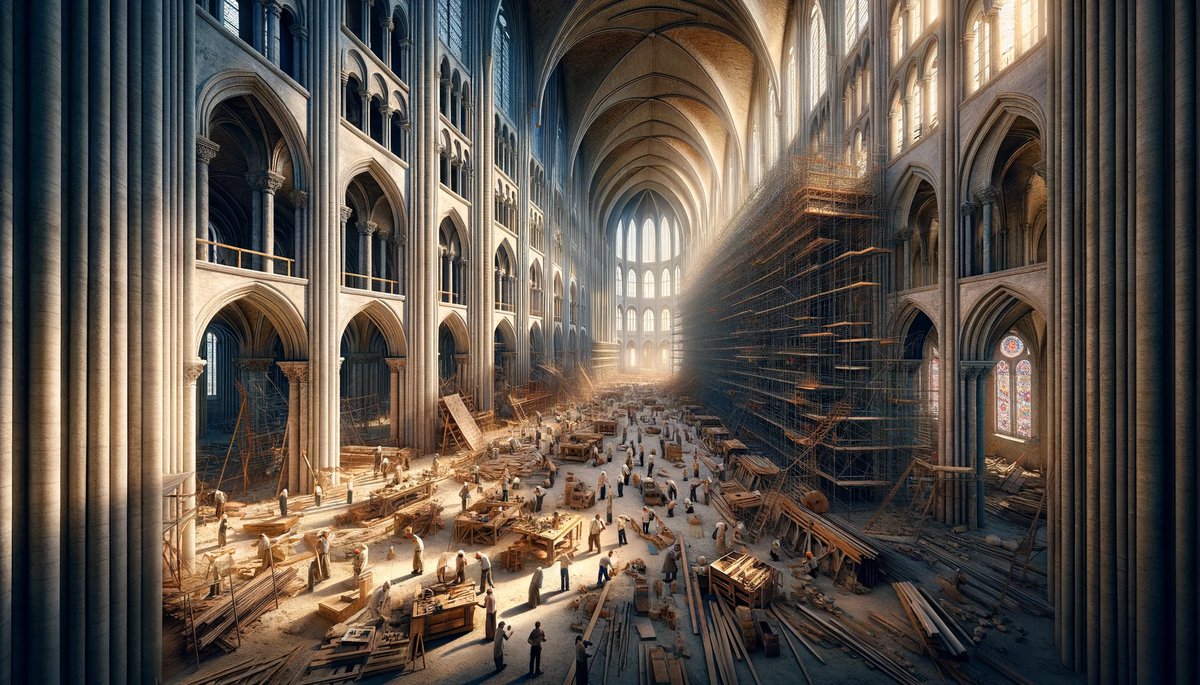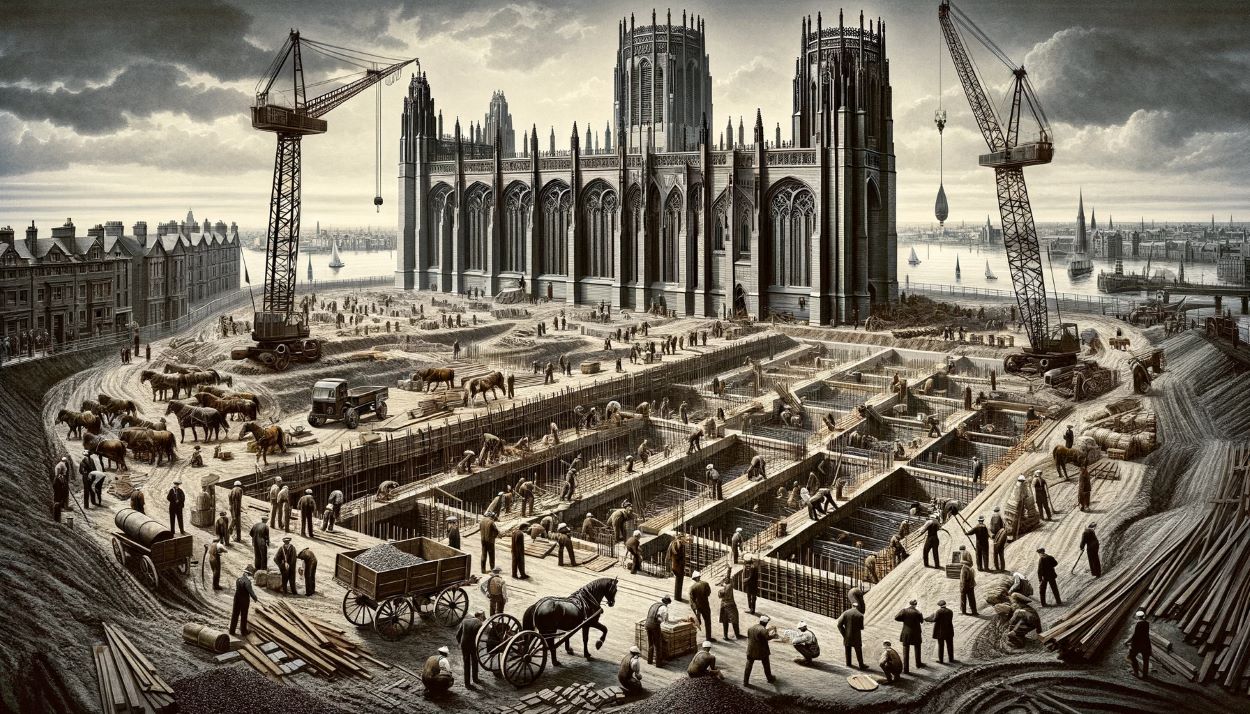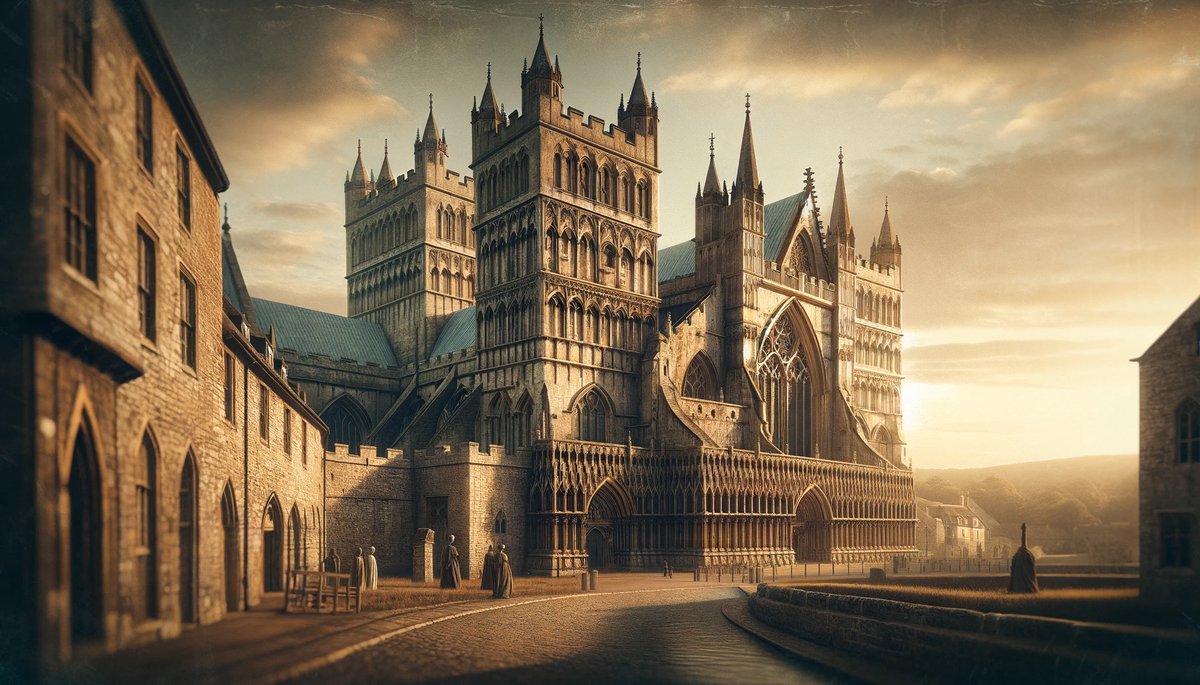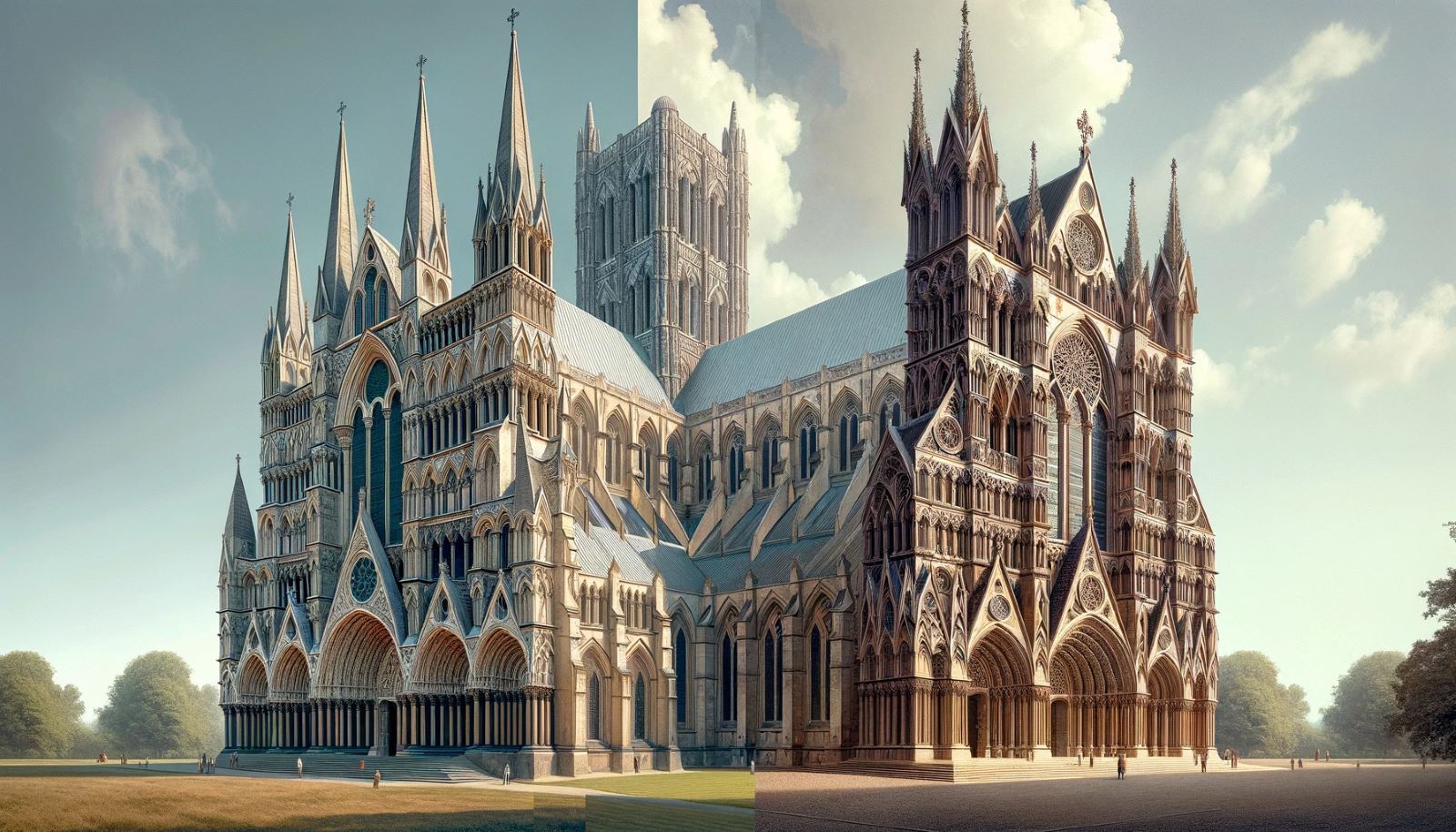Home>Arts and Culture>Why Was The Salisbury Cathedral Built


Arts and Culture
Why Was The Salisbury Cathedral Built
Published: February 17, 2024
Peter Smith, Editorial Director at Christian.net, combines deep insights into faith, politics, and culture to lead content creation that resonates widely. Awarded for his contributions to religious discourse, he previously headed a major organization for religious communicators, enhancing dialogue on faith's societal impacts.
Discover the history and significance of Salisbury Cathedral, a masterpiece of arts and culture, and learn why it was built. Explore its architectural marvels and cultural impact.
(Many of the links in this article redirect to a specific reviewed product. Your purchase of these products through affiliate links helps to generate commission for Christian.net, at no extra cost. Learn more)
Table of Contents
Introduction
Salisbury Cathedral, also known as the Cathedral Church of the Blessed Virgin Mary, holds a significant place in the history of architecture, religion, and culture. This magnificent structure stands as a testament to the ingenuity and craftsmanship of the medieval era, captivating visitors with its awe-inspiring beauty and spiritual significance.
The cathedral's construction began in 1220 and was completed in a remarkably short time of 38 years, a testament to the dedication and skill of the craftsmen and laborers involved. Its location in Salisbury, a city in Wiltshire, England, adds to its allure, as it stands amidst picturesque landscapes, evoking a sense of tranquility and timelessness.
Salisbury Cathedral is renowned for its striking spire, which reaches a height of 404 feet, making it the tallest church spire in the United Kingdom. This architectural marvel continues to draw admirers from around the world, who are captivated by its grandeur and historical significance.
As we delve into the historical context, purpose, and construction of Salisbury Cathedral, we will uncover the stories and intricacies that have contributed to its enduring legacy. From the vision of its creators to the enduring impact it has had on art, culture, and spirituality, Salisbury Cathedral stands as a testament to human creativity and devotion.
Read more: Why Was Salisbury Cathedral Built
Historical Context of Salisbury Cathedral
Salisbury Cathedral, a masterpiece of medieval architecture, emerged during a pivotal period in England's history. The cathedral's origins can be traced back to the early 13th century when the Bishop of Old Sarum, Richard Poore, envisioned a grand structure that would symbolize the power and prestige of the church. The decision to relocate the cathedral from Old Sarum to its current location in Salisbury was driven by a desire to establish a more centralized and accessible place of worship for the growing population.
The construction of the cathedral commenced in 1220 under the guidance of Bishop Poore and his successors, marking the beginning of a remarkable architectural endeavor. The cathedral's design and construction were influenced by the prevailing architectural styles of the time, particularly the Early English Gothic style, characterized by pointed arches, ribbed vaults, and soaring spires. This architectural context provides valuable insights into the cultural and artistic trends that shaped the cathedral's form and structure.
The historical context of Salisbury Cathedral is also intertwined with the broader socio-political landscape of medieval England. The construction of grand cathedrals during this era was not merely a religious undertaking but also a statement of authority and prestige. The cathedral served as a physical manifestation of the church's influence and the wealth of the region, reflecting the aspirations and values of the ruling elite and the clergy.
Furthermore, the cathedral's location in Salisbury, a city with a rich history dating back to prehistoric times, adds layers of historical significance to its narrative. The choice of Salisbury as the site for the cathedral was strategic, as it symbolized the convergence of spiritual, cultural, and political forces in the region. The cathedral's presence in Salisbury continues to be a testament to the enduring legacy of the city and its role in shaping the cultural identity of England.
In essence, the historical context of Salisbury Cathedral provides a window into the medieval mindset, where faith, power, and art converged to create enduring symbols of human achievement. Understanding the historical backdrop against which the cathedral emerged allows us to appreciate its significance as more than just a religious edifice, but as a living testament to the aspirations and endeavors of a bygone era.
Purpose and Function of Salisbury Cathedral
Salisbury Cathedral, with its imposing presence and intricate design, served multifaceted purposes that extended beyond its primary function as a place of worship. At the heart of its existence was the profound desire to create a spiritual and communal center that would inspire awe, foster religious devotion, and symbolize the authority of the church and the divine.
Spiritual Center
As a cathedral dedicated to the Blessed Virgin Mary, Salisbury Cathedral was intended to be a sacred space where the faithful could gather to participate in religious ceremonies, seek solace, and deepen their spiritual connection. The grandeur of the architecture, the ethereal light filtering through stained glass windows, and the reverberating echoes of choral music all contributed to creating an atmosphere conducive to contemplation and prayer. The cathedral's sacred purpose was further emphasized by the presence of relics, religious artworks, and ornate decorations that adorned its interior, serving as tangible expressions of faith and devotion.
Symbol of Authority
Beyond its spiritual significance, Salisbury Cathedral also functioned as a symbol of ecclesiastical authority and the enduring presence of the church in the lives of the people. The cathedral's prominent location in the heart of Salisbury and its towering spire, visible from afar, conveyed a powerful message of the church's influence and prestige. It stood as a physical embodiment of the church's role as a guiding force in the community, exerting moral, cultural, and political influence.
Read more: Salisbury Cathedral: How It Was Built
Community Hub
Moreover, the cathedral served as a focal point for community gatherings, cultural events, and charitable activities. Its expansive nave and transepts provided ample space for processions, public assemblies, and civic ceremonies, fostering a sense of communal identity and civic pride. The cathedral precincts, with their cloisters and gardens, offered a tranquil retreat for contemplation and communal activities, further strengthening the bond between the church and the local populace.
Educational Center
In addition to its spiritual and communal functions, Salisbury Cathedral also played a role as an educational center, where the clergy imparted knowledge, preserved historical records, and promoted artistic endeavors. The cathedral's library, scriptorium, and schools became hubs of learning, nurturing intellectual pursuits and contributing to the preservation and dissemination of knowledge during a time when literacy and scholarship were highly valued.
In essence, Salisbury Cathedral's purpose and function transcended the boundaries of a mere architectural marvel; it embodied the aspirations, beliefs, and communal life of the medieval society, leaving an indelible mark on the cultural landscape of England.
Architectural Features of Salisbury Cathedral
Salisbury Cathedral stands as a pinnacle of architectural achievement, boasting a harmonious blend of structural innovation, artistic expression, and spiritual symbolism. The cathedral's design reflects the prevailing architectural styles of the early 13th century, characterized by the transition from Romanesque to Early English Gothic, resulting in a structure that exudes grace, grandeur, and spiritual transcendence.
Magnificent Spire
The cathedral's most iconic feature is its soaring spire, reaching a height of 404 feet, making it the tallest church spire in the United Kingdom. The spire, constructed in the 14th century, serves as a testament to the ingenuity of medieval craftsmen and the audacious vision of the cathedral's architects. Its slender form and delicate tracery evoke a sense of ethereal beauty, while its sheer height commands attention, drawing the gaze heavenward.
Read more: Why Was The Milan Cathedral Built
Elegant Nave and Transepts
The interior of Salisbury Cathedral is characterized by its spacious nave and transepts, which exemplify the grace and symmetry of Early English Gothic architecture. The pointed arches, ribbed vaults, and slender columns create a sense of verticality and lightness, allowing natural light to suffuse the interior, imparting a celestial ambiance. The nave's unbroken vista, unencumbered by a crossing tower, accentuates the cathedral's sense of openness and unity.
Stained Glass and Sculptural Marvels
The cathedral's interior is adorned with exquisite stained glass windows, renowned for their vibrant hues and intricate narratives depicting biblical scenes and saints. These windows serve as visual sermons, illuminating the faithful and infusing the sacred space with transcendent light. Additionally, the cathedral's sculptural elements, including the intricately carved choir screen and the celebrated "Pillars of Wisdom," showcase the skill and artistry of medieval craftsmen, inviting contemplation and wonder.
Cloisters and Chapter House
The cloisters of Salisbury Cathedral, with their delicate tracery and serene gardens, provide a tranquil retreat, fostering a sense of contemplation and repose. The chapter house, renowned for its octagonal design and vaulted ceiling adorned with medieval paintings, served as a space for the clergy to convene, deliberate, and make decisions, reflecting the cathedral's role as a center of governance and spiritual authority.
Timeless Beauty and Enduring Legacy
Salisbury Cathedral's architectural features, characterized by their ethereal beauty and spiritual resonance, continue to captivate visitors and scholars alike, offering a glimpse into the artistic and religious fervor of the medieval era. The cathedral stands as a living testament to the enduring legacy of human creativity and devotion, inspiring awe and reverence in all who behold its architectural splendor.
Read more: Where Is Salisbury Cathedral
Construction of Salisbury Cathedral
The construction of Salisbury Cathedral stands as a testament to the remarkable vision, dedication, and craftsmanship of the medieval architects, artisans, and laborers who brought this architectural marvel to life. The ambitious endeavor to erect a grand cathedral in the early 13th century was a monumental undertaking, requiring meticulous planning, innovative engineering, and unwavering commitment.
The construction of the cathedral commenced in 1220 under the guidance of Bishop Richard Poore, who sought to create a structure that would surpass the grandeur of its predecessors. The site chosen for the cathedral, located in Salisbury, presented both opportunities and challenges. The marshy terrain necessitated innovative solutions to provide a stable foundation for the soaring edifice. The architects and engineers devised a groundbreaking method of laying the foundation on a raft of logs, distributing the weight of the structure and ensuring its stability—a feat of engineering ingenuity that remains a testament to medieval construction expertise.
The cathedral's construction proceeded at a remarkable pace, with the main body of the structure completed in just 38 years—an astonishing achievement considering the technological limitations of the era. The use of locally quarried limestone, known as Chilmark stone, contributed to the cathedral's distinctive honey-colored façade, adding to its aesthetic appeal and ensuring its durability over the centuries.
The construction process was a collaborative effort, bringing together skilled stonemasons, carpenters, glaziers, and laborers who worked tirelessly to bring the cathedral to fruition. The intricate tracery of the windows, the delicate carvings adorning the interior, and the soaring vaults of the ceiling all bore the mark of master craftsmen who poured their expertise and artistry into every detail.
One of the most remarkable aspects of the cathedral's construction is the audacious addition of the spire, which was erected in the 14th century. The construction of the spire, reaching a height of 404 feet, required meticulous planning and precise execution, as the towering structure posed unprecedented engineering challenges. The completion of the spire solidified Salisbury Cathedral's status as a marvel of medieval architecture, drawing pilgrims, scholars, and admirers from far and wide.
The construction of Salisbury Cathedral stands as a testament to the indomitable spirit of human creativity and determination. It embodies the convergence of art, faith, and engineering, leaving an indelible mark on the cultural landscape and inspiring awe and reverence for generations to come.
Legacy of Salisbury Cathedral
The legacy of Salisbury Cathedral transcends the boundaries of time, resonating through centuries as a testament to human ingenuity, faith, and artistic expression. As a pinnacle of medieval architecture, the cathedral has left an indelible mark on the cultural, spiritual, and historical landscape, shaping the identity of Salisbury and inspiring generations with its enduring legacy.
At the heart of its legacy is the profound impact it has had on architectural innovation and engineering prowess. The audacious construction of the cathedral, culminating in the awe-inspiring spire that reaches for the heavens, stands as a testament to the remarkable achievements of medieval craftsmen and laborers. The cathedral's innovative foundation, the intricate tracery of its windows, and the soaring vaults of its interior all bear witness to the unparalleled skill and vision of its creators, leaving a lasting legacy in the annals of architectural history.
Moreover, Salisbury Cathedral's legacy extends to its role as a spiritual and cultural beacon. As a place of worship and pilgrimage, the cathedral has provided solace, inspiration, and a sense of transcendence to countless visitors over the centuries. Its sacred spaces, adorned with exquisite stained glass and sculptural marvels, continue to evoke a sense of wonder and reverence, fostering a deep spiritual connection with all who enter its hallowed halls.
The cathedral's enduring legacy is also intertwined with its role as a custodian of art, history, and knowledge. Its library, archives, and artistic treasures have preserved the cultural heritage of the region, offering insights into the medieval mindset and the artistic achievements of the era. The cathedral's educational legacy, manifested through its schools and intellectual pursuits, has contributed to the preservation and dissemination of knowledge, nurturing a legacy of scholarship and enlightenment.
Furthermore, Salisbury Cathedral's legacy is reflected in its continued influence on the cultural and social fabric of the region. As a symbol of civic pride and communal identity, the cathedral has been a focal point for community gatherings, cultural events, and charitable endeavors, fostering a sense of unity and shared heritage among the people of Salisbury.
In essence, the legacy of Salisbury Cathedral endures as a testament to the enduring power of human creativity, faith, and communal endeavor. Its architectural splendor, spiritual resonance, and cultural significance continue to inspire awe and reverence, ensuring that its legacy will endure for generations to come.












